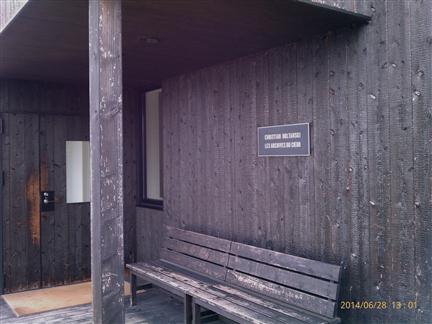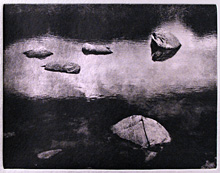Art as Experience
Three Islands in the Inland Sea: Naoshima-Teshima-Inujima
In 1934, John Dewey wrote in Art As Experience of that feeling of exquisite intelligibility and clarity we have in the presence of an of an object that is experienced with aesthetic intensity…. We are, as it were, introduced into a world beyond this world which is nevertheless the deeper reality of the world in which we live in our ordinary experiences. This happens in particular when means and ends coalesce, when the artwork is merely a medium for conducting the viewer into this larger appreciation. If it exists solely as an object, for example as a relic or decoration that has lost its connection with lived experience, then whatever inspirational power it may once have had is gone. This vital truth of art as experience has been discovered and re-discovered by all artists who seek active engagement with the products of their imaginations.
The Tadao Ando-designed Chi-chu (Earth-Ground) Museum on Naoshima stakes its claims of significance on this very precept. In opposition to the traditional role of museums as repositories of art objects, the Chi-chu Museum seeks to create, or actually impose, an experience. And in opposition to the traditional role of architecture to provide shelter, warmth, and a supportive environment for the art of living or working, the Chi-chu Museum offers instead a jarring and occasionally disturbing experience.
Tadao Ando’s signature brut-concrete design with its narrow corridors, sensory deprivation, courtyards of rock fragments contained by high walls, and absurd sequence of up- and down-stairs brings to mind nothing so much as a prison. The effect is accentuated by the arbitrary authority of officious wardens trained to herd visitors into dark corners where they must line up and wait to change footwear. This is necessitated by the floor tiles having been left ungrouted, another design feature that is undoubtedly part of Ando’s genius for removing any smidgen of comfort from the building. Within this sanctum repose three hazy Monets.
Next up is a James Turrell light fixture. After another wait and footwear-change, one is ushered into a room with what appears to be a glowing lavender wall at the top of some black stairs. Suddenly from behind and through this lavender ‘wall’ appears the previous group of visitors. Then the next group ascends the black steps, and, like vestal virgins performing a Greek rite, or like characters in ‘Star Trek’, walks through the lavender ‘wall’. Bathed in an oddly soothing lavender light, suddenly a buzzer sounds loudly as someone inevitably approaches the invisible edge too closely. As the eyes grow accustomed to the pervasive lavender, the white wall behind turns an intense and deep shade of yellow. This is due entirely to an optical illusion created by the lavender-immersion. Descending the black steps, the wall ahead again turns white — a curious experience.
The third of the trio of light-artists, Walter de Maria, offers a 2.2-meter-diameter marble globe flanked by gilded wooden posts on either side of a sloping mini-ampitheatre of a room. A small rectangular skylight changes its reflected position during the day. As neither the skylight nor the door is large enough for the globe to fit through, the entire room must have been built expressly for this object.
With unlimited wealth, it says, you can do just about anything you please. The largesse is from Benesse Corporation, a Japanese company that owns Berlitz and various test-prep schools; its chairman is billionaire Soichiro Fukutake. At a ticket price of 2,060 Yen — that’s about 400 Yen per artwork — visitors may be forgiven for wondering whether ‘Chi-chu’ should be translated as ‘Cheat-you’.
Sprinkled elsewhere on Naoshima are pieces from other luminaries of contemporary art. Complementing Ando’s signature slanted brut-concrete walls are Lee Ufan’s brush-marks, Yayoi Kusama’s polka-dot squash, and Hiroshi Sugimoto’s sea-and-sky half-and-half-tones. Each trademark has attained the readily recognizable status of an avant-garde brand of remarkable longevity, despite or perhaps because of styles that are mannered to the point of obsession.
The Benesse Hotel, another Ando project, has a less forbidding aspect than the Museum, as a hotel must make some concessions to its quasi-residential purpose. Ando’s real forte appears to be walls built seemingly without purpose, like this one which is both monumental and curiously natural at once.
Neighbor island Teshima, 20 minutes by boat from Naoshima, has abundant natural-spring water and terraced rice-fields. Set in the midst of these is the Teshima Art Museum, which evokes this environment with a concrete-shell building by Pritzker-prize-winning architect Ryue Nishizawa, in which water bubbles forth and flows along a very gradually sloped floor to form little rivers and lakes, designed by the artist Rei Naito.
Visitors sit on the floor or walk around in hushed silence, observing this for hours (as I did). It is a little like living inside a Lava-lite. As I got into it, I started wondering about the fate of this or that water droplet, where the slope of the floor would carry it, whether it would link up with others or go its own way, or end up with its identity submerged into the larger whole. It is clearly the most thought-provoking art experience on all three islands.
Situated on a remote corner of Teshima is an exhibit (for 510 Yen) consisting of over-amplified heart-beats in a dark room lit only by occasional blasts of a strobe-light, like a nightmarish rock-concert. Contained in a building with the obligatory wood-burnt-to-a-black-crisp exterior (symbolizing the distress within), the exhibit is accompanied by an elaborate volume of explanatory material, which can be skipped without detriment to one’s education (as could the entire exhibit). 
Teshima’s unique wave-like style of rock wall construction, on view in the village overlooking the Museum, and the sea-grass in the ocean off Naoshima, are some of the most memorable ‘exhibits’ the islands have to offer.
The third island, Inujima, features yet another hyper-modern art museum. This one amplifies the customary dark-corridors-and-bright-lights routine with mirrors. Numerous corners are turned, disorientation ensues, yet the orange orb is visible at every turn, due to large mirrors mounted at 45-degree angles. But that’s not all.
The remains of a house that once belonged to Yukio Mishima were transported to these very premises and suspended in reference to the famous writer who had never visited the island. Note the toilet set in a faux-raked-sand garden, a snarky reference to Duchamp (get it? The Venice Biennale did, in 2010).
Next door is a former copper smeltery and power plant, victims of a sudden drop in copper prices long ago. Had the company survived to witness the current high prices for copper, it might still be providing useful employment for the island’s residents. Not to worry, though, a few of them have acquired new skills involving abstruse explanations of the finer points of the smoke-and-mirrors, dark corridors, and disembodied real estate on display.
The Naoshima – Teshima – Inujima art complex as a whole succeeds in its apparent aim of moving viewers away from the notion of ‘art as object’, and involving, indeed engulfing, them in the overall installation. This movement comes at a rather high price — averaging 400 to 500 Yen per artwork, many times higher than, say, the Louvre — and, more disturbingly, repeated exposure to dark corridors, flashing lights, over-amplified sounds, bizarre up-and-down routings, and similar manifestations of the post-modern mindset. The experience of sensory deprivation combined with arbitrary authority is more an exercise in aversive conditioning than anything else. But to what purpose? Are we being conditioned to accept uncritically the diktats of these purveyors of malevolence?
Surely it is possible to connect art with lived experience in more edifying ways.













